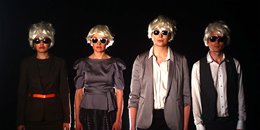Brimming with aphoristically laden dialogue wrapped in a stylistically produced piece, Spilt Gin’s Andy Warhol’s Nothing Special is truly reminiscent of the infamous Factory era. Warhol is all over this tight production where set, acting, directing and musical arrangement coalesce to bring a strange and cool post-modern existential story of love and art, life and death to satisfying fruition. Elegantly clad in mostly shades of silver and announcing themselves on stage in identical white wigs, the quartet cast’s uniformity and beauty mirror the iconic images of Warhol’s tributes to popular culture.
 Framed in this experimental play swathed in the synthetic texture of Warholian absurdity are the notions that love and beauty, art and fame are the ingredients as well as the objectives of the artist’s achievements. To be beautiful, to love beauty, to love beautifully and to become famous dissolve and merge together to achieve the artist’s desire; this is the suggestion inherent in the text, signposting us to the view that life as lived is art itself. Artistic achievement elevated above the mere production of good work and transcending the artist’s life in every detail, is the staple upon which the main character Andy (not Warhol) lives his life.
Framed in this experimental play swathed in the synthetic texture of Warholian absurdity are the notions that love and beauty, art and fame are the ingredients as well as the objectives of the artist’s achievements. To be beautiful, to love beauty, to love beautifully and to become famous dissolve and merge together to achieve the artist’s desire; this is the suggestion inherent in the text, signposting us to the view that life as lived is art itself. Artistic achievement elevated above the mere production of good work and transcending the artist’s life in every detail, is the staple upon which the main character Andy (not Warhol) lives his life.
The dialogue heavily borrows from real Warhol repartee and you could be forgiven for thinking that this is a play about Andy Warhol. In essence it is and it isn’t. It’s about an Andy (Dan Colley), an artist who falls in love with his muse Eve (Lorna Quinn) whose beauty he cannot separate from the objective of love. Although in many ways the play succumbs to looking like a reflection on the real Andy Warhol, it goes further than that and is perhaps more aptly a deconstruction of any artist - or any insecure artist - seeking originality and fame in the same servings.
To borrow from Warhol is perhaps to borrow from the master of style and in this respect the borrower, writer James Hickson, has stolen well - and under Maeve Stone’s subtle direction this interrogation into art and creation emerges as the epitome of Warholian seductiveness and the dandyish pose of cool deeply embedded in the Pop mindset.
The narrative is exposed via snapshots into Andy’s life: his childhood, boyhood and adulthood explored in interview style with Emily Jeffers and Nathan Gordon, who are simply called Woman and Man, serving as the investigators into the world of the ethereal Andy. The overlaying of live and pre-recorded interviews and close-ups of the stage action on a large screen behind the actors reinforces the repetitiveness of Warhol’s imagery.  Matthew Hickson’s sparse set of two white shelving units divided into five by five square compartments each with an electric bulb provides another clever reinforcement of the Pop era influence.
Matthew Hickson’s sparse set of two white shelving units divided into five by five square compartments each with an electric bulb provides another clever reinforcement of the Pop era influence.
On this simple stylish set the actors fill the space to deliver the humour and pathos of Hickson’s script. They inhabit their roles with graceful seductive aplomb weaving about each other in a physically playful choreographed style that is both precise and relaxed. In expressions and utterances their performances are enchanting and engaging, a captivating conveyance of the pithy and sententious narrative which is infused with many quotes from Warhol himself: the fifteen minutes of fame; Coca Cola’s absolute availability to bums and presidents, and the idea that a good painting is a famous painting. Hickson’s use of Warhol created maxims cleverly blended with obvious offbeat truisms in his own dialogue extends the humour of the play to great effect. Asked if he has a mother and father, Colley’s Andy replies, “That’s where I got my big break.” On love he warns that you must keep invoices, “because love is the greatest rip off.”
Musical arrangements inspired by David Bowie and Velvet Underground composed by Jane Deasy aptly complement the setting and physicality of the production.
Breda Shannon is a freelance writer and reviews books for The Irish Examiner.